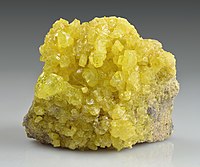
Photo from wikipedia
Cadmium (Cd) is an environmental electrophile that modifies protein nucleophiles, thereby modulating cellular signaling and toxicity. While reactive persulfides/polysulfides exhibit relatively high nucleophilic properties, their roles in the altered gene… Click to show full abstract
Cadmium (Cd) is an environmental electrophile that modifies protein nucleophiles, thereby modulating cellular signaling and toxicity. While reactive persulfides/polysulfides exhibit relatively high nucleophilic properties, their roles in the altered gene expression and toxicity caused by Cd remain unclear. Exposing primary mouse hepatocytes to Cd caused heat shock protein 70 (HSP70) and metallothionein (MT)-I/II to be upregulated and cytotoxicity to occur. These effects were blocked in the presence of polysulfide sodium tetrasulfide (Na2S4). Electrospray ionization mass spectrometry analysis indicated that cadmium sulfide (CdS) and cadmium thiosulfate (CdS2O3) were produced when Cd reacted with Na2S4. Authentic CdS did not cause cellular signaling responses to be activated or hepatotoxic effects, while CdS2O3 had effects similar to those of Cd. HSP70 and MT-I/II upregulation and hepatotoxicity caused by exposure to Cd were significantly enhanced by the deletion of cystathionine γ-lyase (CSE), which catalyzes the formation of reactive persulfides/polysulfides. Deleting CSE also exacerbated Cd-mediated liver injury, whereas little hepatic damage was found when CdS or Na2S4 along with Cd was administered. Overall, the results suggest that the persulfide/polysulfide-mediated formation of sulfur adducts of Cd such as CdS rather than CdS2O3 is, at least in part, involved in decreasing the level of Cd-mediated activation of cellular signaling and toxicity.
Journal Title: Chemical research in toxicology
Year Published: 2017
Link to full text (if available)
Share on Social Media: Sign Up to like & get
recommendations!